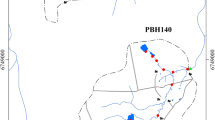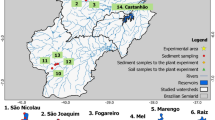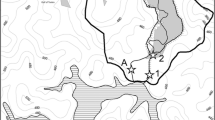Abstract
Topsoil constituents are eroded from agricultural sites and leached towards drainage channels. This transfer can affect aquatic ecosystems and deteriorate the efficiency of drainage systems and fertilisers. As long as erosion cannot be completely avoided, the recycling of sediments and associated nutrients may offer a sustainable solution to these problems. The aim of our case study at the island Sant Erasmo, lagoon of Venice (Italy) was to assess the ecological problems and potentials of sediment recycling. With our assessment we concentrated on (1) the origin of channel sediments, (2) the benefit of sediment application for increasing the nutrient stocks of the soils, and (3) the risk of heavy metal (HM) contamination of arable soils by sediment application. Samples from soils of horticultural sites, sediments, and waters from adjacent drainage channels and lagoon sediments were analyzed for the concentrations of nutrients (P and K) and HM (Cu, Pb, and Zn). Potentially available channel sediment masses and element stocks were calculated for the soil fertility classes of Sant Erasmo based on local measurements of sediment depths and analyses of aerial photographs by a geographic information system. In a column experiment, leaching of both nutrients and Cu from recently dredged sediments was analyzed. Heavy metal concentrations of soils and channel sediments were much higher than of lagoon sediments. The similarity of the chemical properties of the channel sediments and of top soil samples implies that topsoil material is eroded into the channels. The amount of sediments accumulated in the channels corresponded to soil erosion rates between 2 and 23 t ha−1 a−1. Channel sediments contained higher concentrations of nutrients and organic carbon but slightly lower concentrations of HM than the soils of adjacent horticultural sites. Sediment P and K yields would be sufficient to replace fertiliser application at the horticultural sites for up to 51 and 35 years, respectively. The column experiment indicated that Cu mobilization induced by oxidation processes is restricted to the first years after sediments are applied to the soils. Our study emphasizes that for a comprehensive assessment of sediment recycling in agricultural systems the available sediment stocks as well as the contents of nutrients and pollutants of the sediment in relation to soils have to be considered.




Similar content being viewed by others
Abbreviations
- CEC:
-
Cation exchange capacity
- DOC:
-
Dissolved organic carbon
- EC:
-
Electric conductivity
- GIS:
-
Geographic information system
- HM:
-
Heavy metals
- SD:
-
Standard deviation
- SOC:
-
Soil organic carbon
References
Andreasen P, Mortensen PB, Stubsgaard A, Langdahl B (2000) Characterisation of production of organic rich topsoil from sludge. Water Sci Technol 42:195–201
ATV-DVWK (2002) Verdunstung in Bezug zu Landnutzung, Bewuchs und Boden (Evaporation in relation to land use, land cover, and soil). ATV-DVWK Germany M 504:144. In German
Bernardello M, Secco T, Pellizzato F, Chinellato M, Sfriso A, Pavoni B (2006) The changing state of contamination in the Lagoon of Venice. Part 2: heavy metals. Chemosphere 64:1334–1345
BfG—Bundesanstalt für Gewässerkunde (2002) Kommentar zur Handlungsanweisung für den Umgang mit Baggergut im Binnenland, HABAB-WSV (Comment to the guideline for dredged material in German midlands). Koblenz, Germany. In German
BMU—Bundesministerium für Umwelt, Naturschutz und Reaktorsicherheit (1999) Bundes-Bodenschutz- und Altlastenverordnung (BBodSchV) (German federal directive of soil protection and polution legacy). BGBl 1999:1554–1582, Berlin, Germany. In German
Bradford GR, Bair FL, Hunsaker V (1971) Trace and major element contents of soil saturation extracts. Soil Sci 112:225–230
Calmano W (2001) Säurebildungsvermögen und Pufferkapazität (Acidification and buffering capacities). In: Calmano W (ed) Untersuchung und Bewertung von Sedimenten: ökotoxikologische und chemische Testmethoden (Analysis and evaluation of sediments: ecological and chemical tests). Springer, Germany, p 117–120. In German
Canet R, Chaves C, Pomares F, Albiach R (2003) Agricultural use of sediments from the Albufera Lake (eastern Spain). Agric Ecosyst Environ 95:29–36
Childers DL, Corman J, Edwards M, Elser JJ (2011) Sustainability challenges of phosphorus and food: solutions from closing the human phosphorus cycle. Bioscience 61:117–124
Comune di Venezia (1997) Carta della Classificazione Agronomica dei Terreini. Variante per le isole di S. Erasmo et Vignole L.S.24.85. (Map of agricultural soil classification). Venezia, Italy
Correll DL (1998) The role of phosphorus in the eutrophication of receiving waters: a review. J Environ Qual 27:261–266
DVWK (1995) Bodenkundliche Untersuchungen im Felde zur Ermittlung von Kennwerten zur Standortcharakterisierung Teil 1. Ansprache der Böden (Soil analysis for the identification of site evaluation parameters). Bonn, Germany. In German
Elser J, Bennett E (2011) Phosphorus cycle: a broken biogeochemical cycle. Nature 478:29–31
European Community (1998) Council Directive 98/83/EC of 3 November 1998 on the quality of water intended for human consumption. Official J Eur Comm 330:32–54
Fernández-Calviño D, Pateiro-Moure M, López-Periago E, Arias-Estévez M, Nóvoa-Muñoz JC (2008a) Copper distribution and acid-base mobilization in vineyard soils and sediments from Galicia (NW Spain). Eur J Soil Sci 59:315–326
Fernández-Calviño D, Rodríguez-Suárez JA, López-Periago E, Arias-Estévez M, Simal-Gándara J (2008b) Copper content of soils and river sediments in a winegrowing area, and its distribution among soil or sediment components. Geoderma 145:91–97
Finck A (1979) Dünger und Düngung. Grundlagen, Anleitung zur Düngung der Kulturpflanzen. Verlag Chemie, Weinheim-New York, p 336. In German
Fonseca R, Barriga FJAS, Fyfe WS (1998) Reversing desertification by using dam reservoir sediments as agriculture soils. Episodes 21:218–224
Fonseca R, Barriga F, Fyfe W (2003) Dam reservoir sediments as fertilizers and artificial soils. Case studies from Portugal and Brazil. International symposium of the Kanazawa University 21st-century COE program vol 1, p 55–62
Fonseca R, Barriga FJAS, Conceicao P (2010) Clay minerals in sediments of Portuguese reservoirs and their significance as weathering products from over-eroded soils: a comparative study of the Maranhao, Monte Novo and Divor Reservoirs (South Portugal). Int J Earth Sci 99:1899–1916
Fossato VU, Campesan G, Craboledda L, Dolci F, Stocco G (2000) Organic micropollutants and trace metals in water and suspended particulate matter. In: Lasserre P, Marzollo A (eds) The Venice Lagoon ecosystem. Inputs and interactions between land and see. Man and the biosphere book series 25, Parthenon, New York, p 421–437
Frascari F, Matteucci G, Giordano P (2002) Evaluation of a eutrophic coastal lagoon ecosystem from the study of bottom sediments. Hydrobiologia 475:387–401
Girmay G, Mitiku H, Singh BR (2009) Agronomic and economic performance of reservoir sediment for rehabilitating degraded soils in Northern Ehtiopia. Nutr Cycl Agroecosyst 84:23–38
Grandin G (2005) Fish mortality of ponds and channels at Sant Erasmo. Personal interview 18.07.2005, Sant Erasmo, Italy. In Italian and German
Guarnieri A, Fabbri A, Molari G (2005) Influence of sodicity and salinity on the mechanical properties of two Italian soils. Biosyst Eng 91:239–243
Haregeweyn N, Poesen J, Nyssen J, DeWit J, Haile M, Govers G, Deckers S (2006) Reservoirs in Tigray (Northern Ethiopia): characteristics and sediment deposition problems. Land Degrad Dev 17:211–230
Hege U (1994) Effect of different phosphorus fertilization on yield and soil contents. In: Alternatives in land use, in production and utilization of agricultural products. Renewable resources, extensification, set-aside, VDLUFA, Darmstadt, Germany 38:187–190. ISBN 3-922712-52-5
Herms U, Brümmer G (1984) Solubility and retention of heavy metals in soils. Z Pflanzenernähr Bodenk 147:400–424. In German with English abstract
Herms U, Tent L (1982) Schwermetallgehalte in Hafenschlick sowie in landwirtschaftlich genutzten Hafenschlamm-Spülfeldern im Raum Hamburg (Heavy metal contents of harbour sludges and spoil areas under agricultural use in the region of Hamburg). Geol Jahrbuch F 12. Stuttgart, Germany. In German
Kisic I, Basic F, Nestroy O, Mesic M, Butorac A (2002) Chemical properties of eroded soil material. J Agron Crop Sci 188:323–334
Knösche R (2006) Organic sediment nutrient concentrations and their relationship with the hydrological connectivity of floodplain waters (River Havel, NE Germany). Hydrobiologia 560:63–76
LUNG M-V—Landesamt für Umwelt, Naturschutz und Geologie Mecklenburg-Vorpommern (1999) Erarbeitung fachlicher Rahmenbedingungen zur Verwertung von Naßbaggergut aus den Küsten- und limnischen Gewässern Mecklenburg-Vorpommerns in der Landwirtschaft. (Framework for the agricultural use of dredged material from coasts and limnic waters of Mecklenburg-Western). Rostock, Germany. In German
Martin JM, Huang WW, Yoon YY (2000) Dissolved trace metals in the Venice Lagoon. In: Lasserre P, Marzollo A (eds) The Venice Lagoon ecosystem. Inputs and interactions between land and see. Man and the biosphere book series 25, Parthenon, New York, p 23–46
McBride MB, Bouldin DR (1984) Long-term reactions of copper(II) in a contaminated calcareous soil. Soil Sci Soc Am J 48:56–59
Meiwes KJ, Khanna PK, Ulrich B (1986) Parameters for describing soil acidification and their relevance to the stability of forest ecosystems. For Ecol Manage 15:161–179
Ministerio dell’ambiente (1999) Decreto Ministeriale 25 Ottobre 1999, N.471: Regolamento recante criteri, procedure e modalita per la messa in sicurezza, la bonifica e il ripristino ambientale dei siti inquinanti (Federal directive of soil protection, cultivation and emissions). Roma, Italy. In Italian
Mochizuki A, Homma K, Horie T, Shiraiwa T, Watatsu E, Supapoj N, Thongthai C (2006) Increased productivity of rainfed lowland rice by in corporation of pond sediments in Northeast Thailand. Field Crops Res 96:422–427
Olarieta JR, Besga G, Rodriguez R, Uson A, Pinto M, Virgel S (1999) Sediment enrichment ratios after mechanical site preparation for Pinus radiata plantation in the Basque Country. Geoderma 93:255–267
Portnoy JW (1999) Salt marsh diking and restoration: biogeochemical implications of altered wetland hydrology. Environ Manage 24:111–120
Ritchie JC, McHenry JR (1990) Application of radioactive fallout cesium-137 for measuring soil erosion and sediment accumulation rates and patterns: a review. J Environ Qual 19:215–233
Ryding SO (1982) Lake Trehörningen restoration project. Changes in water quality after sediment dredging. Hydrobiologia 91–92:549–558
Sfriso A, Marcomini A (1999) Macrophyte production in a shallow coastal lagoon. Part II: coupling with sediment, SPM and tissue carbon, nitrogen and phosphorus concentrations. Mar Environ Res 47:285–309
Sharpley AN, Smith SJ (1990) Phosphorus transport in agricultural runoff: the role of soil erosion. In: Boardman J, Foster IDL, Dearing JA (eds) Soil erosion on agricultural land. Wiley, Chichester, UK, pp 351–366
Sharpley AN, Chapra SC, Wedepohl R, Sims JT, Daniel TC, Reddy KR (1994) Managing agricultural phosphorus for protection of surface waters: issues and options. J Environ Qual 23:437–451
Siemens J, Ilg K, Lang F, Kaupenjohann M (2004) Adsorption controls mobilization of colloids and leaching of dissolved phosphorus. Eur J Soil Sci 55:253–263
Sigua GC, Holtkamp ML, Coleman SW (2004) Assessing the efficacy of dredged materials from lake Panasoffkee, Florida: Implication to environment and agriculture—part 2: pasture establishment and forage productivity. Environ Sci Pollut Res 11:394–399
Szabolcs I (1981) Salt accumulation in soils.In: Proceedings of the third international soil classification workshop. Damascus, Syria, p 186–198
Temminghoff EJM (1998) Effects of dissolved organic matter on the mobility of Cu in a contaminated sandy soil. Eur J Soil Sci 49:617–628
Van Rompaey A, Bazzoffi P, Jones RJA, Montanarella L (2005) Modelling sediment yields in Italian catchments. Geomorphology 65:157–169
Vandale K, Poesen J (1995) Spatial and temporal patterns of soil erosion rates in an agricultural catchment, central Belgium. Catena 25:213–226
Vanmaercke M, Poesen J, Verstraeten G, de Vente J, Ocakoglu F (2011) Sediment yield in Europe: spatial patterns and scale dependency. Geomorphology 130:142–161
VDLUVA (1991) Bestimmung von Phosphor und Kalium im Calcium-Acetat-Lactat (CAL)-Auszug (Analysis of phosphorus and potassium by calcium-acetate-lactate extraction). Methodenbuch VDLUFA, Bd. I, A 6.2.1.1. In German
Verstraeten G, Poesen J (2000) Assessment of sediment-fixed nutrient export from small drainage basins in central Belgium using retention ponds. In: The role of erosion and sediment transport in nutrient and contaminant transfer. Proceedings of a symposium Waterloo, Canada. IAHS Publ 263
Verstraeten G, Poesen J (2001) Variability of dry sediment bulk density between and within retention ponds and its impact on the calculation of sediment yields. Earth Surf Process Landf 26:375–394
Verstraeten G, Poesen J (2002a) Regional scale variability in sediment and nutrient delivery from small agricultural watersheds. J Environ Qual 31:870–879
Verstraeten G, Poesen J (2002b) Using sediment deposits in small ponds to quantify sediment yield from small catchments: possibilities and limitations. Earth Surf Process Landf 27:1425–1439
Acknowledgments
We express our sincere gratitude to the laboratory team of the Department of Soil Science at the Berlin University of Technology, to the farmers of Sant Erasmo, to Tiberio Scozzafava-Jäger, and to Georg Kubsch, Institute of Chemistry at the Berlin Humboldt University.
Author information
Authors and Affiliations
Corresponding author
Rights and permissions
About this article
Cite this article
Leue, M., Lang, F. Recycling soil nutrients by using channel deposits as fertilizers?. Nutr Cycl Agroecosyst 93, 75–88 (2012). https://doi.org/10.1007/s10705-012-9501-5
Received:
Accepted:
Published:
Issue Date:
DOI: https://doi.org/10.1007/s10705-012-9501-5




